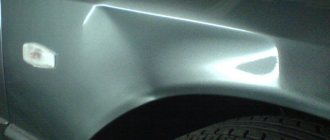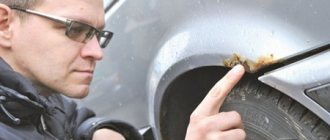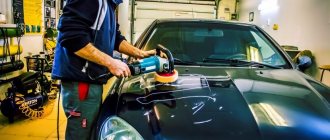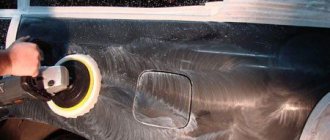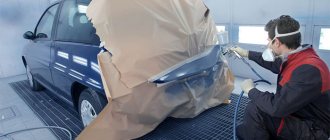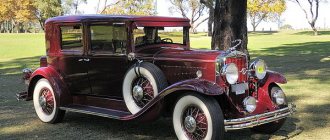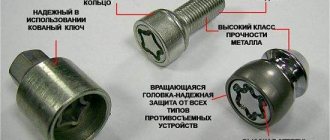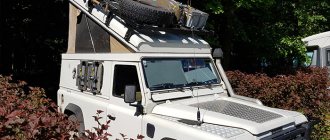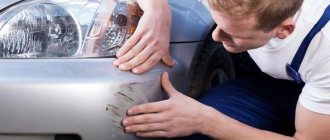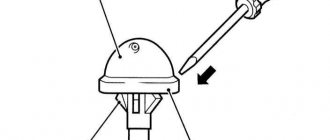What is body straightening
Straightening is a type of body repair work aimed at correcting mechanically damaged parts of the body, removing dents, restoring geometry and giving them their original appearance.
The metal of body parts has three main characteristics: elasticity, rigidity and ductility. Elasticity means the ability to return to its original state when stress is removed. Plasticity is the very quality thanks to which metal can be given the desired shape. When the force on the metal is exceeded, that is, when the permissible limit of its elasticity is exceeded, its molecules deform. In the future, the place of this deformation is not able to return to its original state on its own. At the factory, during stamping, the metal receives similar hardening to maintain the desired lines and shapes. This property is called stiffness.
To correctly assess the amount of work to be done, you need to know the damage characteristics of the material. There are direct and indirect damage to the metal. In the case of direct damage, the damage caused may damage the paintwork or tear the metal at the point of impact. With indirect, deformation occurs in the area adjacent to the impact site. In some cases, it may be some distance from the area of direct damage.
When choosing a restoration method, the location of the damage and its accessibility from the inside are taken into account. In open access, only a hammer and support are used. If the impact area is located inconveniently for repair manipulations, a vacuum suction cup, spotter, and adhesive system can be used for pulling and subsequent adjustment.
The main principle in auto body repair is its simplicity. If possible, it is better not to use special equipment so as not to expose the metal to unnecessary impact. Currently, thin and elastic alloy is used for parts, which makes it possible to correct small dents with just manual force.
Using a pneumatic-hydraulic pump when repairing a car
To edit the frame and body geometry, special equipment is used - a slipway. Carrying out slipway work is the most complex and time-consuming process in the field of car repair. With the help of a slipway, both minor damage and quite complex damage associated with the restoration of body geometry are corrected.
Interesting! Not a single auto repair shop or service station can do without a slipway. Many car enthusiasts have a homemade slipway for body repairs in their garage.
The design of the slipway for car repairs has a pneumohydraulic pump. This tool is used not only when working with a slipway, but also with other garage tools: presses, stretchers, etc. The design features of the pneumohydraulic pump provide its advantages during operation:
- high productivity;
- ease and ease of use;
- simple mechanism for checking and replenishing the oil level;
- A fuse protects the tool from overload during operation.
Many models are equipped with mufflers that provide low-noise operation of the mechanism. Using a pneumatic-hydraulic pump for body repairs significantly speeds up and facilitates the process.
Main stages of straightening
These works are aimed primarily at the impact site itself. The adjacent zones, due to the characteristics of the alloy, will independently return to their previous state. This state of affairs is the most rational and competent. If you approach the issue without careful analysis, there is a risk of causing more damage, which will subsequently result in a large sum.
It is reasonable to divide the upcoming work into three stages:
- diagnostics and analysis of the damaged area;
- rough restoration of shape;
- “polishing” to the intended goal.
In order to competently carry out the first stage of repair, it is better to break it down into key points:
- It is necessary to correctly assess the area of damage and the conditions under which the deformation was obtained;
- Identify the direction from which the crease or dent occurred;
- Find the place where the deformation began - where the collision with the obstacle began;
- Make a plan to eliminate the damage caused in the reverse order of receiving it.
When examining the affected area, it is better to use the tactile method. The entire palm must be moved over the area of metal, since fingers alone will not be able to create an accurate picture of the deformation caused. To enhance tactile sensations, you can wear fabric gloves. A ruler and a file are also used to identify irregularities. Once the paint is removed from the edges of the dent, it will be easier to determine its size and contours.
The second stage is aimed at straightening the main dents and creases to return the original shape of the part. It is not recommended to focus attention on any one place during this work. It is worth gradually returning to shape, making several passes over the entire surface. While straightening dents, the areas bordering the damaged area are tapped at the same time. On the reverse side you can use a wooden beam or a special pillow. Minor defects and irregularities will be eliminated during finishing straightening.
The final stage is essentially cosmetic and its goal is to eliminate the remaining shortcomings. To identify errors, use a block with coarse sanding paper and a special developing agent. Only after careful processing is it permissible to proceed to priming and painting.
Tools and equipment for car engine repair - what exactly do we need?
The content of the article:
Good day, dear car enthusiasts! Have you seriously decided to repair the engine yourself? This is a necessary task, especially since more than 50% of the repair work on the engine is quite feasible and affordable to do yourself.
Today there is no longer a problem in finding and “getting” spare parts, parts or repair kits for a particular engine unit. Tools and equipment for engine repair in any quantity, any size and quality. Instructions and repair manuals for one or another engine unit of any model are available on the Internet.
And the benefits are obvious. Not only will you save money, but with attention and a thorough approach to the matter, you get a 100% guarantee that the operation was performed correctly. After all, repairing an engine with your own hands means: for yourself and with high quality.
Naturally, some technological operations will require special equipment for engine repair. And since you are not going to open a service station in your garage, then there is no need to buy it. In every more or less normal car service center, you will find everything you need.
Essential tool for engine repair
Engine overhaul
Here we will try to more fully list the tools and equipment for engine repairs that, in principle, should be in the garage of any car owner. That is, a tool for everyday use.
You must learn the first rule of an auto mechanic - do not rush to disassemble the engine until you have diagnosed it. Engine diagnostic methods are different, and they all lead to the identification of certain malfunctions of engine components. In addition to motor testers, there are also popular diagnostics, because not every car is equipped with an “electronic brain”.
And measuring compression, for example, will tell you about the condition of the engine no less interesting than the readings of a motor tester. So, tools for engine diagnostics and repair.
- Socket wrenches with replaceable heads . In addition, it is advisable to have working profiles of metric size in the set. These keys are used to dismantle and install all components of the engine and attachments.
- A torque wrench is the most necessary tool for removing and installing the cylinder head.
- Phillips and slotted screwdrivers . These engine repair tools come in different lengths and widths. A couple of powerful screwdrivers will not be superfluous.
- An articulated wrench with a long handle is needed in order to unscrew threaded connections without force.
- Complete set of open-end wrenches . Ideally, it is advisable to have two sets. These keys fail faster than the rest of the tool.
- Combination and adjustable wrenches . These keys are not professional, but for the level of repair work that is carried out in a garage, they are sometimes useful.
- Hammers, pliers, duckbills, side cutters, chisels (of different widths) - these are tools for engine repair, and car repair in general, that should always be by default.
- Punches and bits - made of aluminum or copper, for knocking out shafts and axles, made of steel, for knocking out pins, cotter pins, etc.
- Compression gauge - to measure engine compression, it is advisable to always have it on hand.
- Spark plug key - should be in the garage by default.
- Mechanic's vice - many types of repair work in the garage cannot be done without them.
- an electric drill , for example, to do light honing of the engine cylinders or camshaft. Naturally, in the presence of appropriate hons.
The listed engine repair tools will be enough for you to dismantle or install the cylinder head, cylinder block, camshaft or crankshaft.
Engine repair equipment
Here the question is somewhat more complicated.
You will not be able to concentrate specialized equipment in the garage. Yes, and there is no particular need for this. Boring (honing) of an engine is the prerogative of specialists. You shouldn't take their bread away. The market offers a fairly wide range of specialized equipment for engine repair. These include honing heads and adjustable, reconfigurable diamond reamers, metalworking machines: lathes and drilling.
Equipment for repairing gasoline and diesel engines allows you to perform such complex operations as: repairing the crankshaft bed, repairing camshaft bearings, repairing connecting rods, changing valve guides and restoring the geometry of chamfers on valve seats.
Modern technologies on engine repair equipment make it possible to achieve repair results in terms of compliance with the geometry of parts and assemblies that meet the requirements of engine manufacturers.
After processing the components using specialized equipment for engine repair, you can calmly go to the garage, assemble them with your home tools for engine repair, and then hit the road again.
The most important condition for using any tool and equipment for engine repair is compliance with safety measures during operation. Good luck to you when repairing your car's engine.
Straightening tools
The main device that allows you to perform body work efficiently and comfortably is a slipway. This device can be:
- platform - a five-meter platform with a lifting mechanism and clamps allows you not only to straighten dents, but also act as a lift;
- floor - made in the form of rails attached to the floor and connected to traction mechanisms, has a load capacity of ten tons and is controlled remotely;
- frame - more compact compared to floor-mounted, it extends the body through a frame with a load capacity of 4-7 tons.
A spotter is used to tap small parts. It operates on the principle of a reverse hammer, is quite compact and has proven itself in quickly eliminating defects in the hood, sills, fenders and the body itself, without having to disassemble the car. It is often used for do-it-yourself straightening. However, when purchasing this tool, you need to take into account the nature of the damage.
The simplest and most common tools are a hammer and a mallet. Straightening hammers are divided into several types depending on their use:
- hammer for straightening medium damage;
- a copy for removing more delicate dents;
- inertial hammer to eliminate curvilinear deformations and irregularities;
- flanged allows you to connect and separate flange breaks;
- mallet - a small hammer made of leather, wood, rubber, often complemented by a striker - a removable striker;
- when pulling out a dent, weld a reverse hammer through a hole in the body; This work is quite delicate, since straightening occurs by tapping with a weight and moving the hammer along the canvas.
Anvils and supports are used to place and hold damaged parts of aluminum or other alloys. For DIY repairs, a file, a grinding tool, or its equivalent, an emery wheel, will also be useful. In addition, there are a variety of percussion instruments:
- mount;
- vacuum suction cups that allow you to pull out dents without subsequent painting;
- hammer smoothers;
- notched hammer;
- a device for working on plastic - a set of a hair dryer, air and electric soldering irons, and a hot-melt gun will help complete the finishing straightening.
Other tools may also be useful during the installation process. Services often use a variety of metal hooks with a diameter of 1-1.2 cm, so-called spoons, for working in hard-to-reach places. In such cases, pneumatic hammers are also used.
If the leveler's strength alone is lacking, a lever is used. Whatever the nature of the damage, the most popular tool remains a hammer. However, in some cases it is impossible to do without a set of clamps. The set often includes three items with screws for secure fixation to the canvas.
With all the variety of straightening tools, it is necessary to remember the above rule - do not use complex devices unless absolutely necessary.
Scope of application and types of stretcher sets for car straightening
A set containing hydraulic stretchers is used to exert force on the vehicle’s component structures during body repairs to correct various mechanical damage:
- dents;
- curvatures;
- deformations;
- individual elements;
- straightening of racks;
- suspension straightening;
- other works.
The set of extensions for straightening has a standard appearance and configuration:
- nozzles of different configurations;
- hydraulic pump;
- hydraulic cylinder;
- equipment such as grips and stops;
- extension cords
If desired, this set can be expanded by adding other parts and equipment.
The set containing stretchers for straightening is sold in a convenient special box, which simplifies its transportation and storage. Stretch marks may come with a pump included. Expert opinion
Ilya Vyacheslavovich
Consultant for body repair at krasymavto.ru
Ask a Question
A standard set for correcting body defects usually does not have it, but this powerful tool allows you to significantly increase stretching forces.
The stretch marks themselves are divided according to the mechanism of influence on structures as follows:
- equipment with tensile forces, necessary, for example, for straightening a door arch;
- a tool with tightening forces (tie), which is used to tighten elements of the car, for example, a fender damaged as a result of a collision.
Information! This equipment can carry out work on straightening the car body, trunk, roof and hood.
When carrying out such work, the equipment can reach a force of 5 tons. The equipment can also be used for straightening various metal components and parts, correcting distortions of car elements, and replacing thresholds.
Straightening technologies
Conventionally, all types of work carried out to eliminate deformations can be divided into 4 classes:
Classic (regular) straightening
Involves the use of hammers, levers, jacks, spoons, clamps, and in rare cases, resistance welding. Aimed at correcting local damage to the body. It is done by applying frequent blows with hammers, smoothing with shaped tiles, squeezing out with hooks, spoons and using other techniques.
Vacuum straightening
Its use is possible if there are no sharp edges at the dents and the paintwork is intact. Damage of this nature appears after unintentional contact with body parts. To correct this kind of defect, it is enough to place a vacuum suction cup on a degreased and wet surface, and then sharply pull it towards you. If the damage is very minor, a household suction cup (from a rear view mirror or organizer) will be sufficient. The most important thing in this method is to find the place of greatest tension. The advantage of this straightening is that there is no need to dismantle the part, the paintwork remains intact, and it takes little time.
Hot straightening
Most often, a gas torch is used to soften the part. Its use is recommended only in extreme cases, or in the hands of a specialist. A safer alternative is to use a hair dryer.
Selling tools in Ukraine on OLX
Finding high-quality and affordable new and used tools is not easy. However, with the help of our ad service, it is possible to buy tools for your home inexpensively. For example, a craftsman offering on OLX will need an excellent screwdriver at an affordable price.
We have a large assortment of products in the “Tools” category divided into groups:
- hand tool;
- petrol tools;
- power tools;
- pneumatic tools, etc.
Advertisements for each construction tool are accompanied by several photos and a detailed description of its functionality, which allows the consumer to make a choice. If you are unable to find what you need, we suggest writing to the “buy tools” section on our website.
Hooks, levers and other devices
For a straightener who is working to give a deformed body its original shape, the following will also be useful for performing the full scope of repair work on car surfaces:
Straightening hooks must be made of metal with a thickness of at least 10-12 mm.
- Convex, elastic, stretching, leveling, universal spoons.
Spoon-like tools bend and pull out hard-to-reach (internal) parts of the body.
- Other levers for contact repairs.
Levers are used where ordinary human effort is not enough.
Car straightening and straightening is carried out starting with the largest dent, using suitable tools, while straightening hammers remain the main straightening device.
Measuring the “geometry” of the body
p, blockquote 6,0,0,0,0 —>
To understand where and how much the power elements of the body have shifted, various measuring systems are used to measure geometric parameters.
p, blockquote 7,0,0,0,0 —>
Most often, in garage workshops and small car repair shops, rulers are used to measure body geometry, as well as simple tape measures.
p, blockquote 8,0,1,0,0 —>
It is not always convenient to use a tape measure, since there may be various obstacles on the path of the two points between which you need to measure the distance (especially in the engine compartment). A measuring ruler allows you to take measurements quite easily (see the article on measuring body geometry).
p, blockquote 9,0,0,0,0 —>
